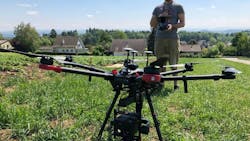Hyperspectral system suitable for various agriculture applications
AgriCircle (Rapperswil-Jona, Switzerland; www.agricircle.com), a company in the field of digital modeling, the preparation of data, and the development of decision support for agriculture, developed a system to measure biodiversity in flora, make diseases visible, and identify problematic weeds.
Peter Fröhlich, AgriCircle CEO, states, “With satellites, we identify regional biodiversity clusters and then are looking for high-resolution biodiversity in the identified areas. It is important to identify different plants and their distribution in the area. What is needed to do that is a hyperspectral camera covering 400-1000 nm with maximum 10 nm spectral bandwidths.” The company is using hyperspectral cameras from Photonfocus (Lachen, Switzerland; www.photonfocus.com) with more than 30 bands in the 400-950 nm range for snapshot images to achieve this task.
The snapshot camera system uses two hyperspectral sensors. A MV0-D2048x1088-C01-HS03-160-G2 16 band irradiance sensor provides correct measures to calculate reflectance at all times automatically. The camera has a processor that optimizes the capture (exposure time), performs reflectance calculations, directly co-registers the images from the two cameras, and delivers a stacked geo-tiff. The processor also stitches images together and assigns different clusters to different plants in real time. This is used to assign different clusters to different plants. The second camera in the system is a Photonfocus MV0-D2048x1088-C01-HS02-160-G2.
The software used has been developed by ASXProcessing (Niederhasli, Switzerland) together with Photonfocus. The software takes irradiance measures, the pictures taken, and creates co-registered reflectance cubes. It also performs fast stitching on the fly. Other software used includes normal GIS tools such as PIX4D to get highly accurate orthomosaics.
Today there is a working prototype that is delivering high-quality results directly in the field. Fröhlich comments, “The system is the answer to most use cases in the field and delivers a great data size to outcome ratio.”
About the Author
Chris Mc Loone
Editor in Chief
Former Editor in Chief Chris Mc Loone joined the Vision Systems Design team as editor in chief in 2021. Chris has been in B2B media for over 25 years. During his tenure at VSD, he covered machine vision and imaging from numerous angles, including application stories, technology trends, industry news, market updates, and new products.

